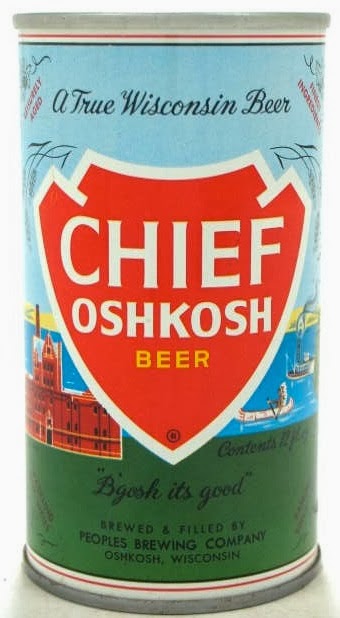giftedeye2
Well-Known Member
- Joined
- Aug 11, 2020
- Messages
- 49
- Reaction score
- 12
I have been wanting to recreate an old beer from the Oshkosh area that would be fun for my family to drink and reminisce back to the day it was a household beer. I found the following recipe on a blog site (props to whoever shared this: The Story of Chief Oshkosh Beer and How to Brew It)
I was wondering if anyone ever tried this - and is the grain bill listed good as is or do I need to add extract? (Still relatively new to all grain)
Brewing Chief Oshkosh Beer
This is a homebrew version of the 1950's Chief Oshkosh Beer. This recipe is based on information that originated at the brewery.
Style: Premium American Lager
Boil Volume: 7.5 Gallons
Batch Size: 5.5 Gallons
Efficiency: 75%
Boil Gravity: 1.034
Original Gravity: 1.046
Final Gravity: 1.012
Alcohol By Volume: 4.52%
IBUs: 20-25
Color: 2.5-3 SRM
Grist
6-Row Pale Malt: 6.5 pounds (70%)
Flaked Corn: 2.75 pounds (30%)
Extract brewers would need to perform a mini-mash and then supplant the remaining grist with either Light or Pilsen malt extract.
Hops
.7oz Cluster boiled for 60 mins to achieve approximately 19 IBUs
.3oz Cluster boiled for 10 mins to achieve approximately 3 IBUs
Yeast
Wyeast 2035 American Lager / Average Attenuation: 75%
Ferment at 50º F
Process
Mash in at 154º F / Rest for 60 minutes
Boil for 90 minutes
At OBC, they used corn grits that they gelatinized by boiling. They also employed a step mash to break down the bullish protein content of 6-row malt. Neither method is required for the recipe presented here.
Fermentation
Primary Fermentation: 10-14 days @ 50º F
Secondary Fermentation: 4-6 weeks @ 36º F
Carbonate the beer to 2.5-3 volumes
I was wondering if anyone ever tried this - and is the grain bill listed good as is or do I need to add extract? (Still relatively new to all grain)
Brewing Chief Oshkosh Beer
This is a homebrew version of the 1950's Chief Oshkosh Beer. This recipe is based on information that originated at the brewery.
Style: Premium American Lager
Boil Volume: 7.5 Gallons
Batch Size: 5.5 Gallons
Efficiency: 75%
Boil Gravity: 1.034
Original Gravity: 1.046
Final Gravity: 1.012
Alcohol By Volume: 4.52%
IBUs: 20-25
Color: 2.5-3 SRM
Grist
6-Row Pale Malt: 6.5 pounds (70%)
Flaked Corn: 2.75 pounds (30%)
Extract brewers would need to perform a mini-mash and then supplant the remaining grist with either Light or Pilsen malt extract.
Hops
.7oz Cluster boiled for 60 mins to achieve approximately 19 IBUs
.3oz Cluster boiled for 10 mins to achieve approximately 3 IBUs
Yeast
Wyeast 2035 American Lager / Average Attenuation: 75%
Ferment at 50º F
Process
Mash in at 154º F / Rest for 60 minutes
Boil for 90 minutes
At OBC, they used corn grits that they gelatinized by boiling. They also employed a step mash to break down the bullish protein content of 6-row malt. Neither method is required for the recipe presented here.
Fermentation
Primary Fermentation: 10-14 days @ 50º F
Secondary Fermentation: 4-6 weeks @ 36º F
Carbonate the beer to 2.5-3 volumes




